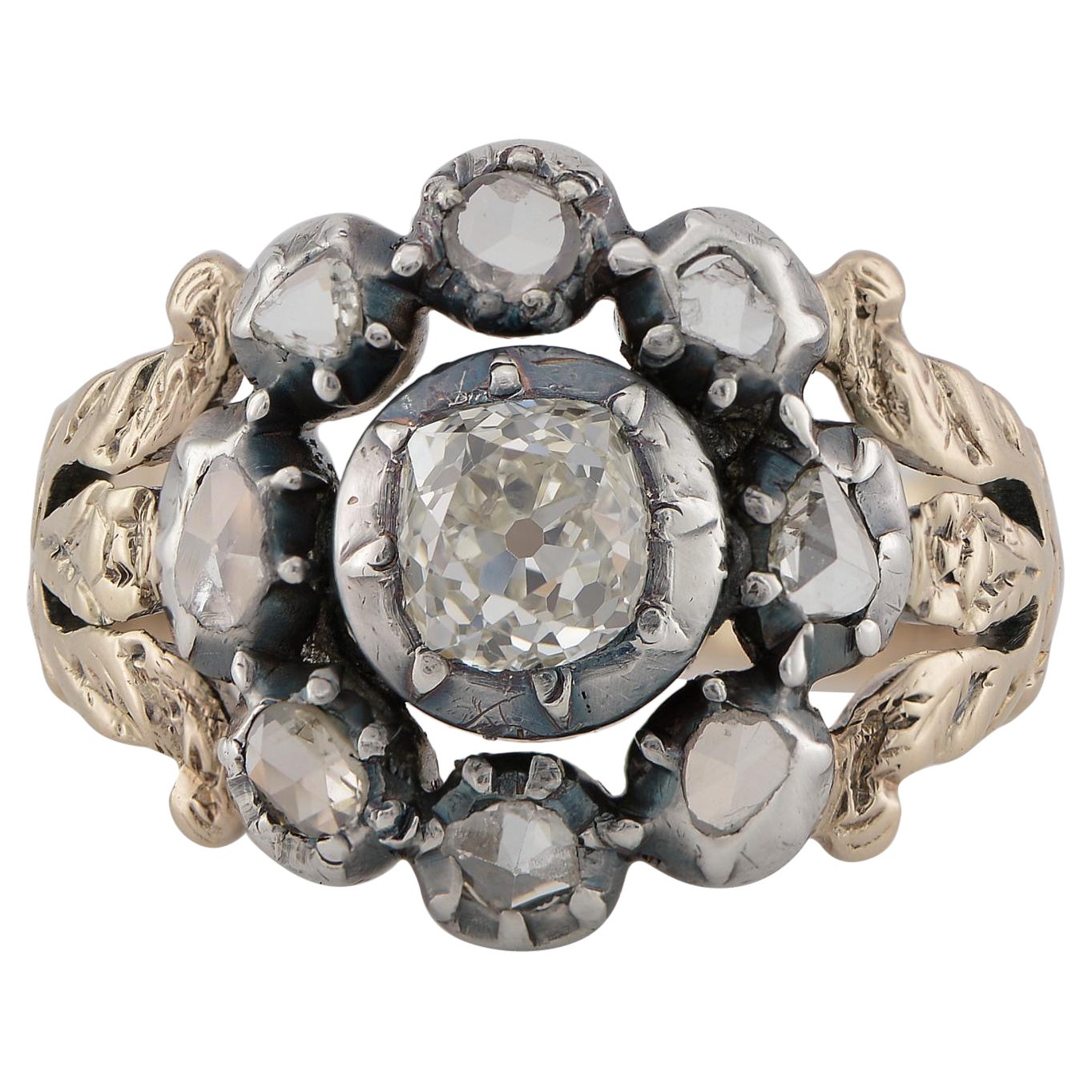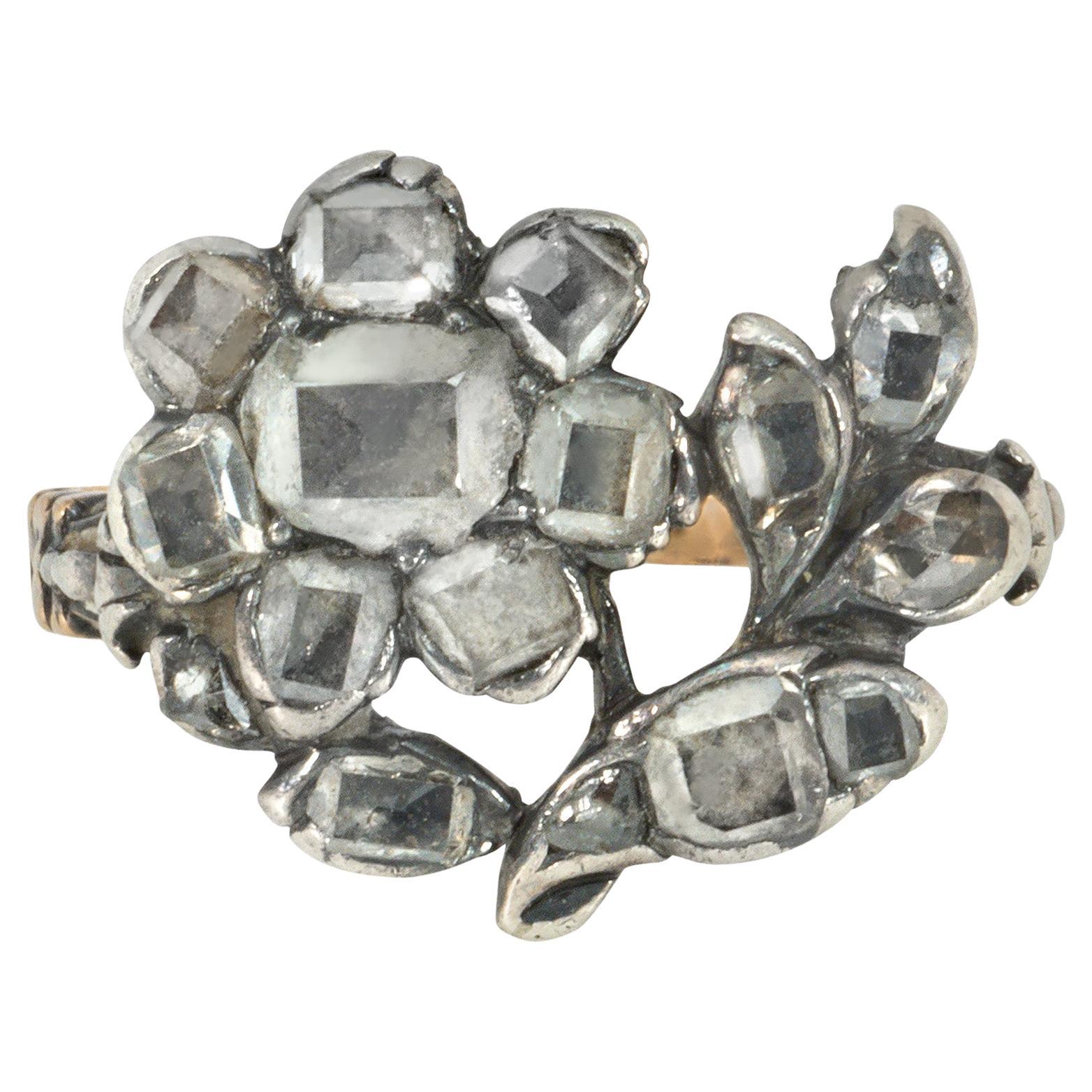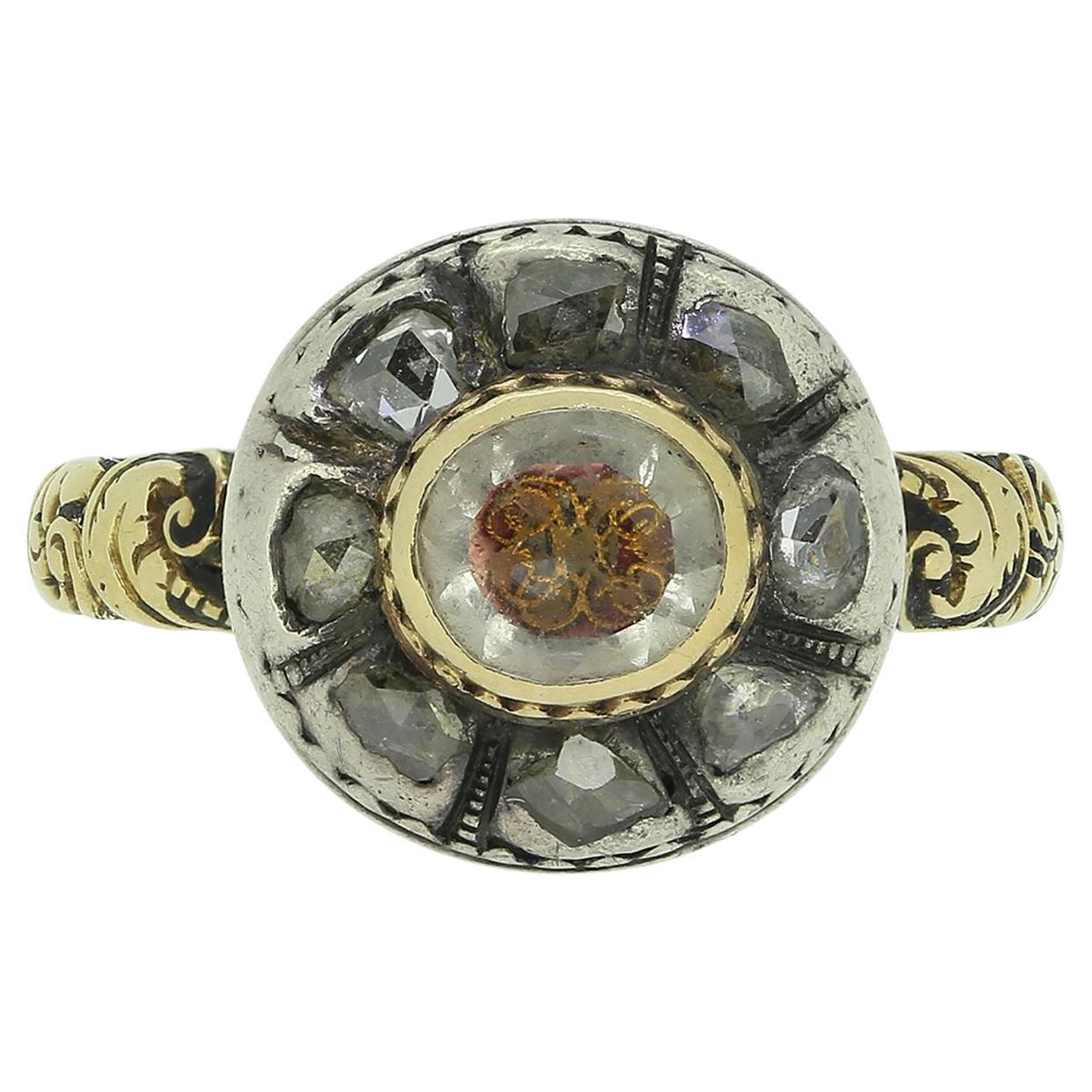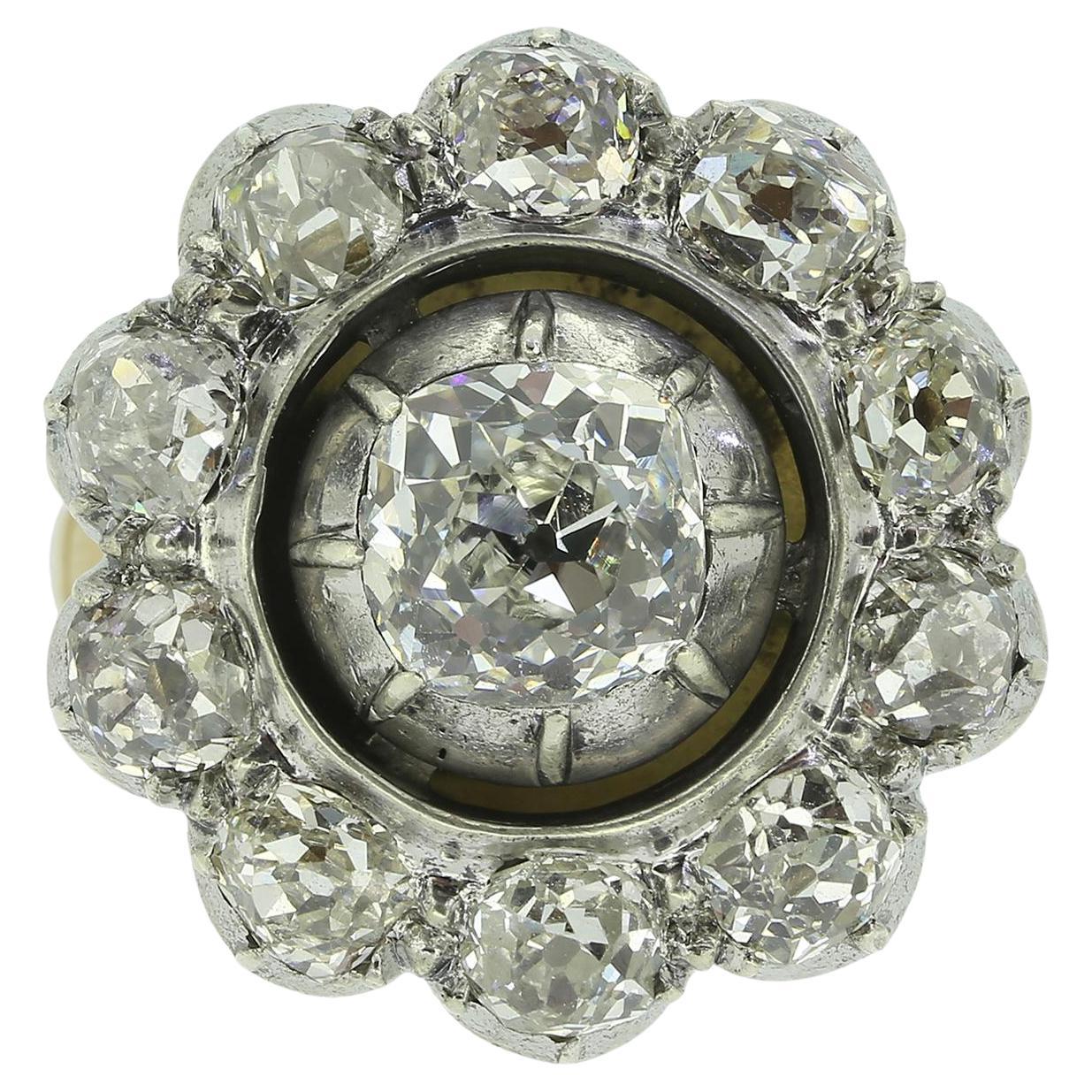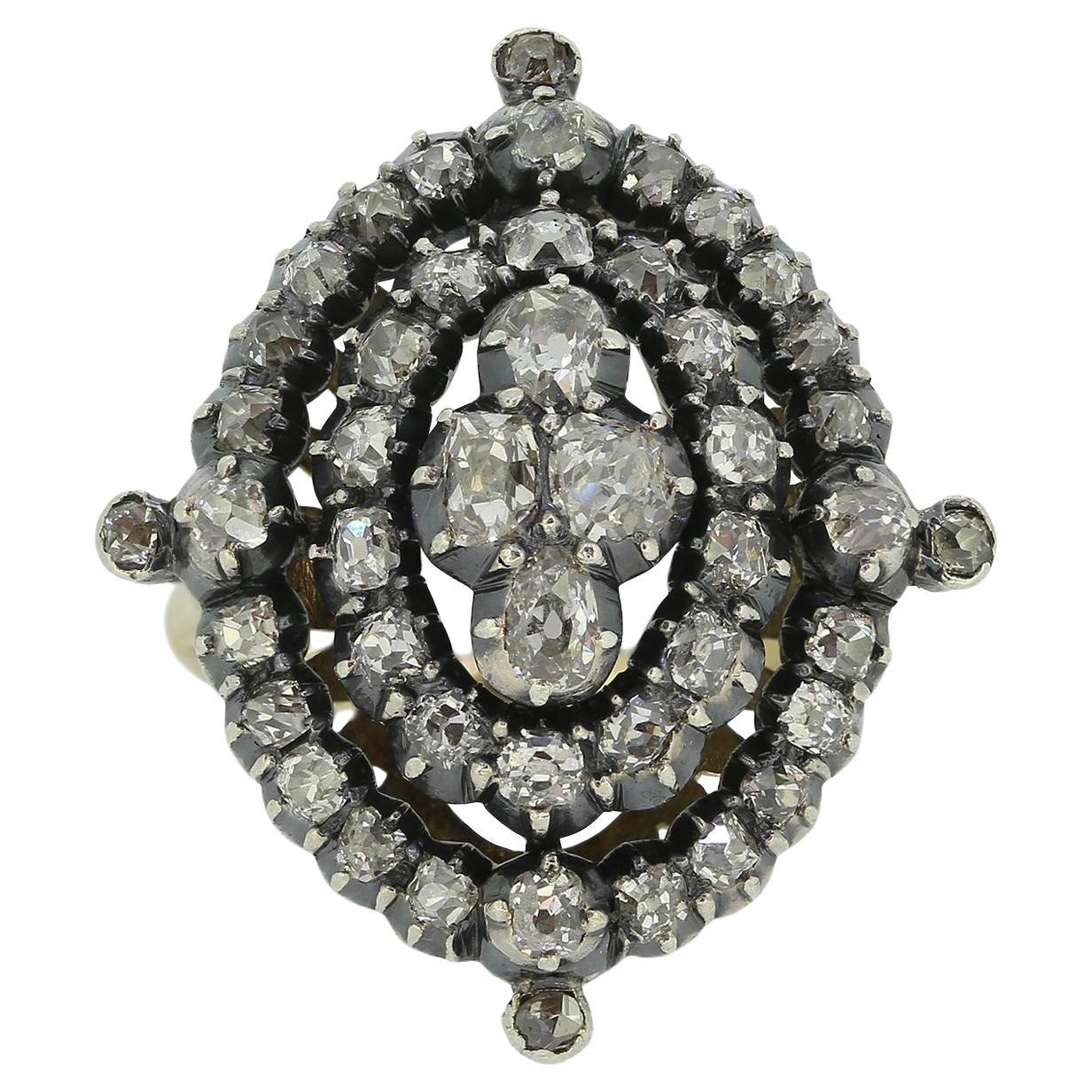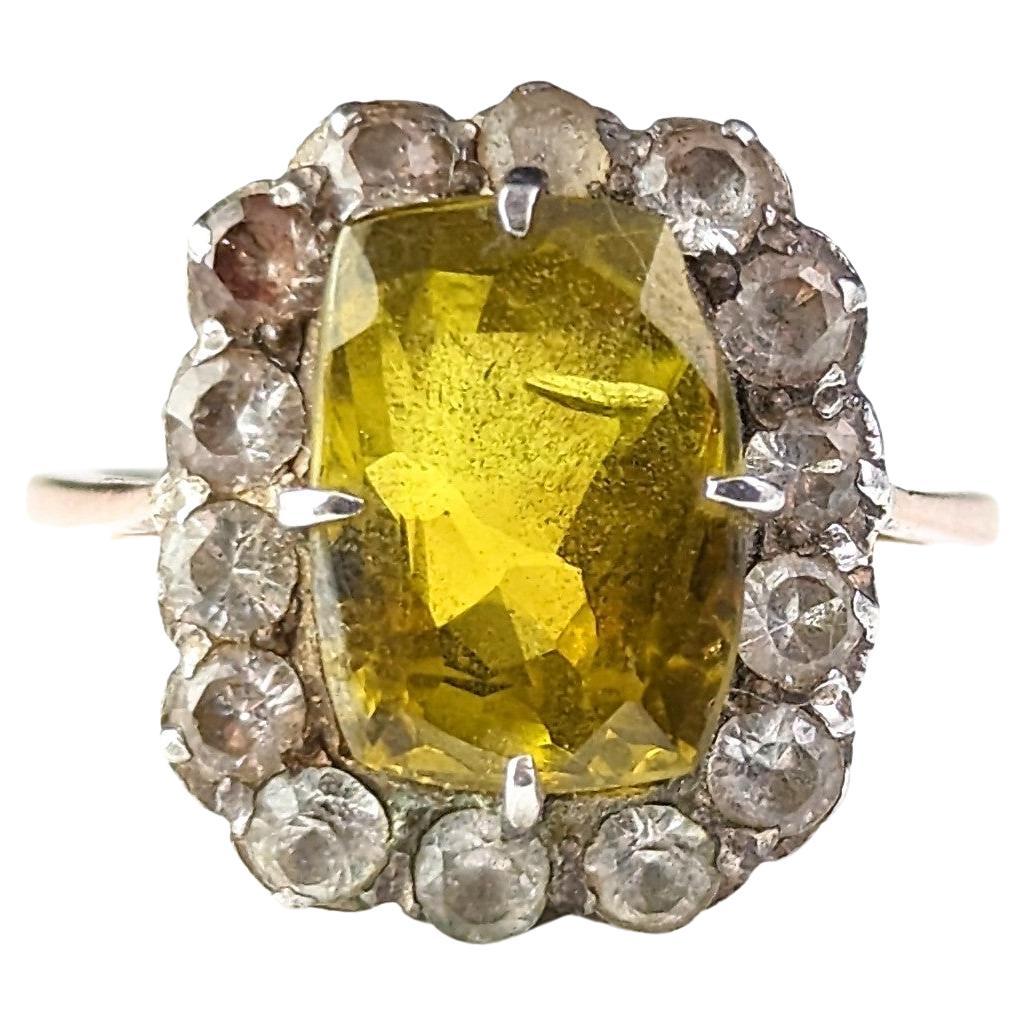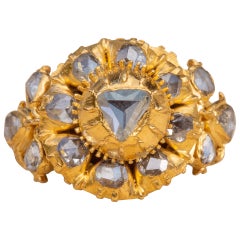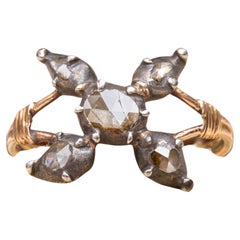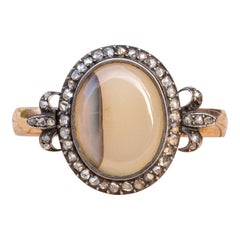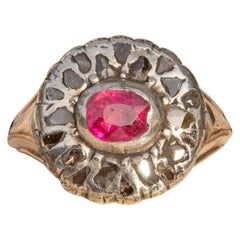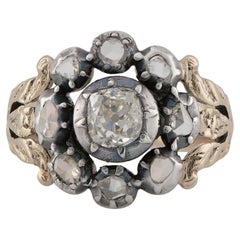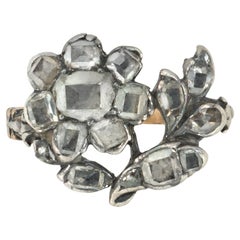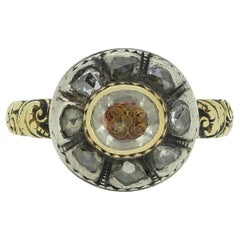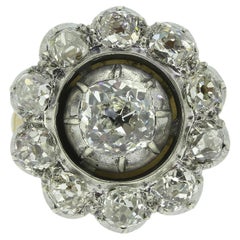Items Similar to Rare 18th Century Portuguese Cluster Ring Minas Novas Rock Crystal Antique
Video Loading
Want more images or videos?
Request additional images or videos from the seller
1 of 19
Rare 18th Century Portuguese Cluster Ring Minas Novas Rock Crystal Antique
$4,110.50
£3,000
€3,499.34
CA$5,630.36
A$6,262.19
CHF 3,269.92
MX$76,204.15
NOK 41,761.86
SEK 39,165.25
DKK 26,116.90
Shipping
Retrieving quote...The 1stDibs Promise:
Authenticity Guarantee,
Money-Back Guarantee,
24-Hour Cancellation
About the Item
A rare Portuguese 18th century ‘minas novas’ rock crystal cluster ring, circa 1770. A lovely example of Georgian period Portuguese jewellery, this marquise-shaped ring was crafted in 15K gold and displays excellent craftsmanship. The larger central faceted stone is surrounded by two concentric rows of densely set rock crystals, separated by a gold beaded border which is a typical feature of Portuguese jewels of this period. The stones are all in foil-backed and closed settings, allowing the stones to glisten marvellously in candlelight. They range from greenish-sea foam to pale dusty blue in appearance, some with an even darker lustre. The closed underside of the bezel is curved to align with the natural curvature of the finger. Although the original shank has been replaced, probably from a resizing done in the late 19th to early 20th century, the colour and style of the later shank match the rest faithfully.
Minas novas refers to rock crystals or quartz which originate from Minas Gerais, Brazil. The late 18th century saw a wealth of Portuguese jewellery design as bountiful gemstone yields from these Portuguese-controlled mines allowed jewellers to experiment with sumptuous designs using a variety of colourful gems including quartz, topaz, beryl and chrysoberyl.
This elegant ring sits fairly flat on the finger to allow for frequent wear and remains in great wearable condition despite its significant age. Under loupe magnification, there are some age-related abrasions to the gem facet junctions (difficult to spot with the naked eye) and some damage to one of the stones (causing it to appear darker). There is also some age-related patina, tarnish, and light surface wear to the gold. As the stones are in foil-backed settings, you should limit exposure to water when wearing this jewel, as it might make the foil darken and cause the stones to appear dull.
Two very similar late 18th century Portuguese cluster rings are in the Koch collection (no. 957 and 958), “Rings: The Alice and Louis Koch Collection” by Anna Beatriz Chadour (message for photo for example).
UK size N 1/2, US size 7
7.41g, unmarked but tests as 15K gold. The cluster head measures 28mm x 18mm.
- Ring Size:7 US, Resizable
- Metal:
- Stone:
- Stone Cut:
- Weight:7.41 g
- Style:
- Place of Origin:
- Period:
- Date of Manufacture:1770
- Condition:Wear consistent with age and use.
- Seller Location:London, GB
- Reference Number:1stDibs: LU2845220500712
Resizing is available.
About the Seller
5.0
Vetted Professional Seller
Every seller passes strict standards for authenticity and reliability
Established in 2019
1stDibs seller since 2022
46 sales on 1stDibs
- ShippingRetrieving quote...Shipping from: London, United Kingdom
- Return Policy
Authenticity Guarantee
In the unlikely event there’s an issue with an item’s authenticity, contact us within 1 year for a full refund. DetailsMoney-Back Guarantee
If your item is not as described, is damaged in transit, or does not arrive, contact us within 7 days for a full refund. Details24-Hour Cancellation
You have a 24-hour grace period in which to reconsider your purchase, with no questions asked.Vetted Professional Sellers
Our world-class sellers must adhere to strict standards for service and quality, maintaining the integrity of our listings.Price-Match Guarantee
If you find that a seller listed the same item for a lower price elsewhere, we’ll match it.Trusted Global Delivery
Our best-in-class carrier network provides specialized shipping options worldwide, including custom delivery.More From This Seller
View AllImportant 19th Century Royal Siam Diamond Cluster Ring Museum-Grade Thai
Located in London, GB
An outstandingly rare mid-19th century royal Siam diamond cluster ring, made by the royal goldsmiths of the court of Bangkok.
This is an extremely fine example of the jewellery commissioned and subsequently bestowed by the Kings of Siam, principally to be worn by participants in royal and aristocratic life-cycle ceremonies in the courts of Bangkok. In the mid-19th century, King Mongkut (Rama IV) of Siam also commissioned the courtly jewellers to create a number of faithful replicas of these ceremonial jewels to be offered as gifts to diplomatic families, important visitors and to Heads of State across the world when re-establishing diplomatic relationships. One such example (which is remarkably similar to the present ring) resides in the museum of the Château de Fontainebleau (item F1518C) where it was given as a gift from King Mongkut to Napoléon-III on the important ambassadorial visit of 1861 (see photos for a side by side comparison).
Ceremonial Use:
During the 19th century, many rings were made every year by the royal jewellers for ceremonial use. Examples of these lavish cluster rings being worn for these life-cycle ceremonies can be seen on old photos and paintings of the Royal Tonsure Ceremony, also known as ‘the cutting of the top-knot’ ceremony, which marked the transition from childhood into adulthood for all of the (many!) sons and daughters of the Siam royal family.
The huge expansion in the number of royals in 19th century Siam stemmed from Kings Mongkut (Rama IV) and Chulalongkorn (Rama V) being highly polygamous. They had a joint total of 124 wives and 159 royal children, each requiring their own ceremonial regalia and princely jewels. As a result, Bangkok became home to some incredibly skilled goldsmiths in this period. The Tonsure ceremony was performed by the King, and lasted three days and three nights. All of the royal children would be dressed in the most splendid costumes and adorned with a vast amount of jewels on several parts of the body. Their costumes and jewels differed according to their title and rank. Diamonds for instance, would be bestowed to the highest ranking noble children. The royal children were allowed to keep their regalia and jewels as a present on entering adulthood to indicate their social status among society.
Over the years, these royal jewels have been dispersed across the many noble families, with currently only a few important pieces remaining in the royal collection. Today, the number of royals in Thailand is contracting as the country follows the Chinese nobility system whereby with each generation the noble rank of a family decreases by one ranking so that eventually the majority of descendants will lose their noble status completely. This loss of royal privilege, coupled with the dilution of wealth has meant that items such as this ring become available on the open market. Following the end of the absolute monarchy in Thailand in 1932, many members of the royal family relocated to Europe and as a consequence, princely Thai items can occasionally be found in the European art market.
Gift Exchange:
In Siam culture, great importance is placed on the ancestral process of gift-exchange. During the reign of King Mongkut, close relationships with some powerful countries were cultivated in order to hold the balance of power and to save Siam from being colonised. The King used gift-exchange to establish diplomatic relations with other heads of state around the world, as well as with other kings, princes and sultans closer to home. He sent troupes of ambassadors to England (1857) and France (1861) with seemingly endless amounts of trunks filled with lavish gifts in order to dazzle the heads of state with the extraordinary quality and variety of Siam craftsmanship.
These gifts consisted of faithful replicas of the Royal Regalia and objects belonging to the King himself; items and jewellery worn by him on his Tonsure ceremony and on his coronation day. Enormous time and effort was required by the Siam court to assemble these numerous gifts, as they emanated from the very same royal goldsmiths and courtly craftsman who had made the original ceremonial items.
The most famous of these ceremonies took place at the Chateau de Fontainebleau in 1861. The painting by Jean-Léon Gérôme that immortalised the event prominently features the most spectacular of these gifts. Among the 150 gifts presented to Napoléon-III by the Siam ambassadors were two diamond-set rings, both of which are on display in the Musée du Chateau de Fontainebleau (item no. F1518C and F1519C). One of these rings is a rose cut diamond cluster and bears a striking resemblance to the ring we are offering. According to Bruley (2011), this ring, presented to Napoleon-III, was a faithful replica of the ring worn by King Mongkut on his own coronation day in 1851, which now resides in the Pavilion of Royal Regalia in Thailand.
The Ring:
From whichever angle the present ring is viewed, it is a masterpiece of design and a testament to the ingenuity and craftsmanship of the Siam royal goldsmiths. The bezel head is composed of two layers, the uppermost, containing the large triangle shaped table-cut diamond, is riveted to the main body of the ring. The second layer of the cluster is set with a further eight rose cut diamonds and this section allows for small rotation, typical of Siam jewellery...
Category
Antique Mid-19th Century Thai Victorian Cluster Rings
Materials
Diamond, 22k Gold
Scarce Antique Georgian Rose Cut Diamond Flower Floral Cluster Ring Rare Design
Located in London, GB
A superb antique Georgian diamond cluster ring, circa 1780-1820.
The silver-topped gold bezel exhibits a floral cluster of rose cut diamonds, all in closed-back rubover silver sett...
Category
Antique Late 18th Century Dutch Georgian Cluster Rings
Materials
Diamond, 18k Gold
Antique Mid-19th Century, French 18K Agate and Rose Cut Diamond Cluster Ring
Located in London, GB
This stunning antique cluster ring was made in France and dates to around the mid 19th century, circa 1860. In the centre rests a smooth banded agate in an open back setting, encircled by a halo of rose cut diamonds in closed-back, cutdown silver settings with a combined approximate weight of 0.15 carats. The ring has a decorative pierced gallery in the form of crescents and a solid semi-circular shank. The shoulders are decorated with two applied fleur-de-lis, each set with rose cut diamonds in silver settings.
The main colour of the milky agate is a creamy-brown hue with a darker brown band on one side. The diamonds are rose cut, the triangular facets of these cuts were very popular during the Georgian and Victorian periods as they glistened more beautifully in candlelight than any other cut.
This elegant ring sits flat on the finger, the stones are secure in their settings and the ring is in superb condition despite its significant age, a truly rare find!
UK size U / US size 10, 5.44g, French ’tête...
Category
Antique Mid-19th Century French Victorian Cluster Rings
Materials
Agate, Diamond, 18k Gold
Scarce Antique Georgian Pink Ruby and Diamond Floral Cluster Ring c 1800 Italian
Located in London, GB
This unusual antique Georgian era floral ruby and diamond cluster ring dating to around 1800 was probably made in Italy. In the middle of the ring head lies a collet set and foil-backed bright pink ruby. It is surrounded by a sea of 20 flat-cut and closely set diamonds in a flower head cluster style. The raised ruby setting appears to fixed to the ring with a cut-down rivet which is visible on the smooth underside of the bezel. The rosy hued gold ridged shoulders taper down to the back of the shank. This elegant ring sits fairly flat on the finger to allow for frequent wear and is without doubt a particularly unusual and scarce example of its kind.
UK size L 1/2, US size 6
4.72g, band tests as 14K gold, bezel tests as silver, ring head measures 14mm x 13mm. Each diamond measures between 1mm and 3mm. Approx 0.3ct...
Category
Antique Early 1800s Italian Georgian Cluster Rings
Materials
Diamond, Ruby, 14k Gold, Silver
Antique Georgian Early 19th Century 1ct Ruby and Diamond Target Cluster Ring
Located in London, GB
A superb antique Georgian ruby and diamond ring made in England, circa 1820. The centre of this ‘target’ shaped cluster ring is set with a 1ct cushion cut deep red ‘pigeon’s blood’ r...
Category
Antique Early 19th Century English Georgian Cluster Rings
Materials
Diamond, Ruby, 22k Gold
Rare Georgian Diamond Crowned Heart Ring Antique Engagement Ring c.1740 Rose Cut
Located in London, GB
This rare and enchanting early Georgian 'Crowned Heart' ring dates back to circa 1740, a stunning precursor to the modern engagement ring. Such rings were gifted as tokens of love an...
Category
Antique Mid-18th Century Rococo Engagement Rings
Materials
Diamond, 18k Gold, Silver
You May Also Like
Georgian/Regency Diamond Cluster Ring Ring
Located in Napoli, IT
Journey to Georgian Times
Magnificent and rare example of Georgian / Regency period Diamond cluster ring, 1800 ca
Skillfully hand crafted of solid 18 Kt gold and silver portion in th...
Category
Antique Early 1800s European Georgian Cluster Rings
Materials
Diamond, 18k Gold, Silver
French Antique Mid-18th Century Table-Cut Diamond Jardinière Ring
Located in New York, NY
An antique Georgian period table-cut diamond giardinetto ring in the form of a flower, in sterling silver and 18k gold. France
* Includes letter of a...
Category
Antique 1750s French Georgian Cluster Rings
Materials
Diamond, 18k Gold, Sterling Silver
Early 18th Century Stuart Crystal and Diamond Cluster Ring
Located in London, GB
Presenting a highly detailed and rare cluster ring from the early stages of the 18th century. This antique piece showcases a centralised crystal with an embedded floral motif encircl...
Category
Antique 18th Century Georgian Cluster Rings
Materials
Crystal, Diamond, 18k Gold, Yellow Gold, Silver, Enamel
Antique Old Cut Diamond Cluster Ring
Located in London, GB
Here we have an exquisite cluster ring featuring a centralised antique cushion-cut diamond radiating a captivating white hue. This principal stone is elegantly collet-set whilst bein...
Category
21st Century and Contemporary Georgian Cluster Rings
Materials
Diamond, Gold, 18k Gold, Yellow Gold
Victorian Old Cut Diamond Cluster Ring
Located in London, GB
Here we have a striking diamond cluster dress ring taken from the Victorian period. At the centre of this open face we find a quartet of chunky old cut diamonds. These four stones si...
Category
Antique 19th Century Victorian Cluster Rings
Materials
Diamond, Gold, 18k Gold, Yellow Gold, Silver
Antique Victorian Chrysoberyl and Paste cluster ring, 9k gold and silver
Located in NEWARK, GB
This gorgeous antique Chrysoberyl and Paste cluster ring is just the piece if you are looking for an interesting new addition to your antique ring collection.
She is crafted in rich...
Category
Antique 19th Century British Victorian Cluster Rings
Materials
Chrysoberyl, 9k Gold, Silver
More Ways To Browse
Large Crystal Ring
Crystal Quartz Rings
Portuguese Cut Jewelry
Portuguese Cut Stone
Antique Foil Jewelry
Portuguese Gold Ring
Antique Topaz Jewelry
Antique Crystal Lustres
Chrysoberyl Gem
Antique Portuguese Jewelry
Antique Loupe
Antique Chrysoberyl Jewellery
Antique Blue Topaz
Nova Jewelry
Antique Topaz Ring
Antique Portuguese Rings
Georgian Rock Crystal
Brazilian Antique Ring
